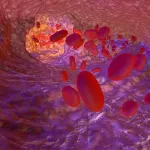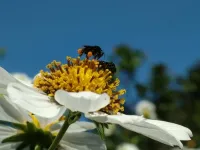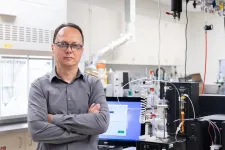A simple blood test can now diagnose De Vivo disease
2023-06-05
(Press-News.org)
Glut1 deficiency syndrome is a rare and disabling neurological disease still relatively unknown to the medical community. A mutation in the SLC2A1 gene in affected patients causes the glucose transporter GLUT1 to malfunction. Since this transporter is responsible for the glucose entering glial cells, the brain is deprived of some of the sugar it needs to function correctly, leading to seizures, bouts of abnormal movement, and developmental delays.
These symptoms can be improved by managing the metabolic disorder that causes the disease via a high-fat diet, known as the ketogenic diet. In addition, promising new therapeutic molecules designed to compensate for the poor supply of glucose to brain cells are currently being evaluated. “Patients who are not diagnosed suffer a regrettable loss of opportunity. They could be treated, says Professor Fanny Mochel, principal investigator of the study. There is an urgent need to identify them better since many are missing or diagnosed too late.”
The incidence of Glut1 deficiency syndrome is estimated to be 1 in 24,000 in the general population. This figure is probably underestimated, as it only considers epileptic patients and not those with isolated, non-specific symptoms such as learning disabilities or abnormal movements. The diagnosis is even more challenging to make because it was previously based on a lumbar puncture supplemented by genetic tests. “This invasive, often lengthy, and expensive procedure significantly limits access to care, adds the researcher. Hence the interest in looking for a blood biomarker to enable a rapid diagnosis of Glut1 deficiency syndrome.”
Red blood cells lined with clues
Indeed, the GLUT1 transporter is not only abundant in endothelial and glial cells of the brain: it also binds to the surface of erythrocytes, the red blood cells. The diagnostic test designed by the Paris-based medtech METAFORA biosystems makes it possible to quantify GLUT1 on their surface by flow cytometry, a technique routinely used in analysis laboratories. A simple blood sample is required to perform the test without the need to take a fasting patient. The result is available in 48 to 72 hours.
To validate the new test – METAglut1 – teams from AP-HP and 33 French clinical investigation centers, under the direction of Professor Fanny Mochel, recruited 549 patients in a prospective cohort – that is to say, people in whom the disease was suspected – and 87 patients from a retrospective cohort, already diagnosed. The goal? To compare the efficacy and accuracy of METAglut1 with the reference diagnostic test requiring cerebrospinal fluid sampling and genetic analysis.
The researchers' results indicate that METAglut1 has a sensitivity of about 80%, a specificity of more than 99%, and a high predictive value, a performance comparable to the reference test. “These data allow us to validate the benefit of the test formally, says Professor Fanny Mochel. It will make it possible to look for Glut1 deficiency syndrome in many patients simply and quickly. In the event of a positive result, treatment can be started immediately, significantly improving the prognosis, especially for children in the midst of brain development.”
Therefore, the study’s authors recommend that the test be performed in all children from 3 months of age and adults with intellectual disability, neurodevelopmental disorders, abnormal movements, or epilepsy - especially if it is drug-resistant and if a ketogenic diet alleviates the seizures. Indeed, if used at an early symptomatic stage, METAglut1 can immediately identify 80% of patients with Glut1 deficiency syndrome. For this reason, French National Authority for Health recommends its reimbursement, which paves the way for its adoption in Europe and the US.
END
[Attachments] See images for this press release:

ELSE PRESS RELEASES FROM THIS DATE:
2023-06-05
The use of mobile technologies to collect and analyze individuals’ location information has produced massive amounts of consumer location data, giving rise to an elaborate multi-billion-dollar system in which consumers can share personal data in exchange for economic benefits. But privacy risks prevail.
In a new study, researchers used machine learning to create and test a framework that quantifies personalized privacy risks; performs personalized data obfuscation; and accommodates a variety of risks, utilities, and acceptable levels of risk-utility tradeoff. The framework ...
2023-06-05
Among the most fundamental questions in astronomy is: How did the first stars and galaxies form? NASA’s James Webb Space Telescope is already providing new insights into this question. One of the largest programs in Webb’s first year of science is the JWST Advanced Deep Extragalactic Survey, or JADES, which will devote about 32 days of telescope time to uncover and characterize faint, distant galaxies. While the data is still coming in, JADES already has discovered hundreds of galaxies that existed when the universe was less than 600 million years old. The team also has identified galaxies sparkling with a multitude of young, hot ...
2023-06-05
A delicate tracery of dust and bright star clusters threads across this image from the James Webb Space Telescope. The bright tendrils of gas and stars belong to the barred spiral galaxy NGC 5068, whose bright central bar is visible in the upper left of this image – a composite from two of Webb’s instruments. NASA Administrator Bill Nelson revealed the image Friday during an event with students at the Copernicus Science Centre in Warsaw, Poland.
NGC 5068 lies around 20 million light-years from Earth in the constellation Virgo. This image of the central, bright star-forming regions ...
2023-06-05
A new ‘digital decision support tool’ enabling the transition towards more diversified and sustainable agricultural systems has been developed by an international team of researchers from Germany, France, and Czech Republic.
The research led by Dr Ioanna Mouratiadou from the Leibniz Centre for Agricultural Landscape Research, and published in Environmental Science and Ecotechnology, presents the ‘Digital Agricultural Knowledge and Information System (DAKIS)’ as a data integration ...
2023-06-05
Baltimore, MD—New work led by Carnegie’s Phillip Cleves uses cutting-edge CRISPR/Cas9 genome editing tools to reveal a gene that’s critical to stony corals’ ability to build their reef architectures. It is published in Proceedings of the National Academy of Sciences.
Stony corals are marine invertebrates that build large skeletons, which form the basis of reef ecosystems. These biodiversity hotspots are home to about a quarter of known marine species.
“Coral reefs have ...
2023-06-05
Human influences have the potential to reduce the effectivity of communication in bees adding further stress to struggling colonies, according to new analysis.
Scientists at the University of Bristol studying honeybees, bumblebees and stingless bees found that variation in communication strategies are explained by differences in the habitats that bees inhabit and differences in the social lifestyle such colony size and nesting habits.
The findings, published today in PNAS, reveal that anthropogenic change, such as habitat conversion, climate change and the use of agrochemicals, are altering the world bees occupy, and it is becoming increasingly clearer that this affects communication ...
2023-06-05
· Regulating cell mechanics stimulates hair growth in mice
· Next step will be testing if delivering microRNA via nanoparticles grows hair
· Potential for human hair growth
CHICAGO --- Just as people’s joints can get stiff as they age and make it harder for them to move around, hair follicle stem cells also get stiff, making it harder for them to grow hair, reports a new Northwestern Medicine study.
But if the hair follicle’s stem cells are softened, ...
2023-06-05
McKinney, TX., June 5, 2023 - The Cure Mito Foundation, a parent-led organization dedicated to advancing research and treatments for Leigh syndrome, has launched the first-of-its-kind online resource about Leigh syndrome, the most common type of pediatric mitochondrial disease.
The free resource, “About Leigh Syndrome” (https://www.aboutleighsyndrome.com), serves as a central place where patients, caregivers and doctors can find information on Leigh syndrome, including its symptoms, diagnosis, treatment options, and more. Translation ...
2023-06-05
Risk assessment instruments (RAIs) are widely used to inform high-stakes decision making in the criminal justice system and other areas, such as health care and child welfare. These tools typically assume a relation between predictors and outcomes that does not vary with time. But because societies change, this assumption may not hold in all settings, generating what a new study calls cohort bias—a bias resulting from cohort-wide influences not experienced by past or future cohorts.
The study, by researchers ...
2023-06-05
An innovative and sustainable chemistry developed at the Department of Energy’s Oak Ridge National Laboratory for capturing carbon dioxide from air has been licensed to Holocene, a Knoxville-based startup focused on designing and building plants that remove carbon dioxide from atmospheric air.
“ORNL is tackling climate change by developing numerous technologies that reduce or eliminate emissions,” said Susan Hubbard, ORNL deputy for science and technology. “But with billions ...
LAST 30 PRESS RELEASES:
[Press-News.org] A simple blood test can now diagnose De Vivo disease






